LEAP Annual Learning Report – Summary of Key Findings
Summary Report
Annual Learning Report 2021/2022
Early help for very young children in Lambeth – how our services are learning and evolving
Message from Laura McFarlane, Director, Lambeth Early Action Partnership (LEAP)
I am delighted to introduce our first Annual Learning Report.
The findings in this report give us a real opportunity to develop a deeper understanding of our programme. The report shows how our services are supporting children and families to have a better start, whilst also giving us crucial insight into which families we are reaching and working with via our services.
There is much to celebrate in this report!
To date, LEAP services have worked with over 14,200 children and families. Many families rate LEAP services very highly and parents report feeling more knowledgeable and confident in supporting their child’s development.
This report also offers food for thought. We are committed to continue learning from these emerging findings to further our understanding of the families in the LEAP area and how our services are received.
Many people are involved in bringing these insights together. From parents who complete questionnaires and feedback forms, to practitioners who regularly submit data. The LEAP Core Team have skilfully analysed and presented these findings, so we are able to share our learning. I would like to offer my thanks to all involved in this work.
I invite you to read this summary report for an overview of the findings and then dive deeper into the full report for detailed analysis of some of the outcome areas LEAP works on.
As we approach the final stages of the LEAP programme, I am confident that the insights and stories contained in this report will enable us to focus on areas for improvement and development as well as creating a strong evidence base for our local Lambeth system and beyond.
I hope you will find this report useful and inspirational.
Laura McFarlane
Director
1.0 About LEAP Lambeth
What is early help and support and why is it important?
Lambeth Early Action Partnership (LEAP) is one of five local partnerships which make up A Better Start, a national ten-year (2015 – 2025) programme funded by The National Lottery Community Fund that aims to improve the life chances of babies, very young children, and families.
LEAP works with a wide range of children, families, practitioners, and organisations across Lambeth. We fund, improve, and evaluate over 20 local services, meeting the needs of families through pregnancy and the early years of childhood.
Our aim is to:
- Improve early child development outcomes for all children living in the LEAP area
- Reduce local inequalities by supporting those at greater risk of poor outcomes.
LEAP delivers services in parts of Lambeth (‘the LEAP area’) where young children experience greater inequalities than children in the rest of the borough. The LEAP area is home to almost a fifth of children under 4 in Lambeth1. While LEAP has some targeted services that are only available to families living in the LEAP area, other services are available to all families living in Lambeth, and some are open to anyone who wants to attend.
Services fall into two groups:
- Services that work directly with children to help them reach their developmental milestones.
- Services that support children indirectly, by working with parents, early years practitioners, and the wider community, so they are better equipped to provide the responsive relationships and positive experiences that children need.
LEAP is a ‘collective impact initiative’, which means that all our services and activities link together and work towards shared goals to improve outcomes for young children.
2.0 About this research
This report presents emerging insights about our overall reach and the learning taken from our Shared Measurement System. It has been written by LEAP’s team of researchers and analysts.
We routinely collect and analyse data from across the LEAP programme. This helps us monitor performance across services, track progress towards outcomes, and continuously learn and improve. Data is stored in our innovative Integrated Data Platform. We have been collecting some data since the start of LEAP in 2015, including the number and demographics of people accessing our services. However, some feedback and outcomes data has only been collected more recently as part of our Shared Measurement System, (which started in 2021).
This report presents findings on the reach of LEAP services across the complete programme portfolio. It then details findings from across the programme on four of our Theory of Change outcome domains: 1, 2, 3 and 6. These domains had the best data available at the time our analysis began in March 2022.
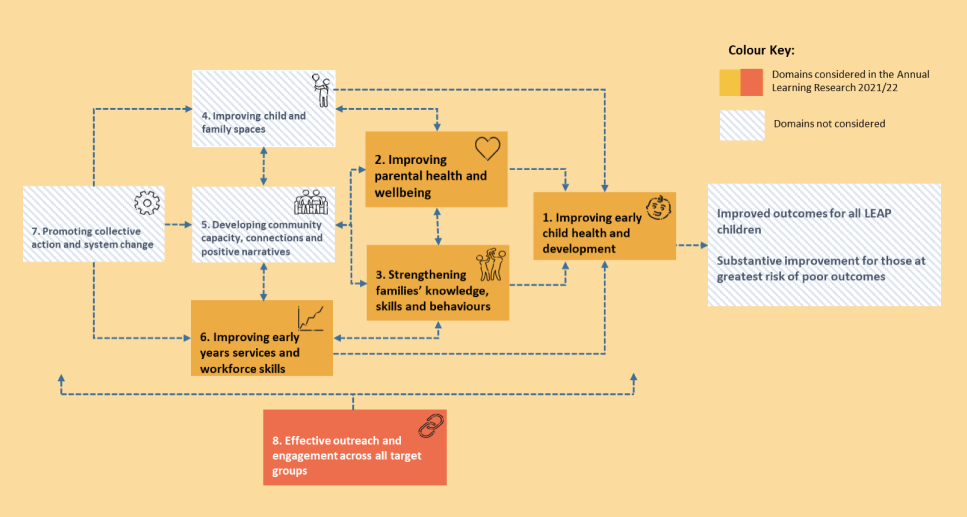
By analysing routine service data, LEAP intends to learn what works in early years, to improve both evidence and practice. These findings will be used internally by the LEAP team to drive learning and improvement. By sharing them publicly, we also seek to build external knowledge of the LEAP programme.
3.0 Our Impact – how LEAP is driving early childhood development
Reach and engagement; communicating with parents in the early years
Key findings
- Over the lifetime of the programme, LEAP services have reached over 14,200 children and families (6,966 children and 7,239 parents or carers).
- An additional 5,038 individuals have been reached through our lighter touch community engagement activities which include festivals and events curated by the LEAP community engagement team.
- Families engaging with LEAP services broadly reflect the ethnic diversity of the population, though anecdotally we know there are still some groups who are less likely to engage.
- 49% of families engaged in services live in the LEAP area. Another 42% live in other areas in Lambeth, while 9% live outside the borough.
- Mothers account for 87% of the parents and carers we engage, while fathers account for only 7%. The remaining 7% are made up of other carers such as other family members and childminders.
- The vast majority (85%) of children and families who engage with LEAP attend only one service, with 14% attending between two and four services.
- LEAP has provided capacity building support to 1,681 practitioners across the early years workforce
Reflections on our reach and engagement
It is encouraging to see that the LEAP programme is on track to achieving our goal of giving more than 10,000 children in Lambeth a better start in life. It is also encouraging that the ethnic background of families engaged with LEAP services broadly represent the demographics of the wider population, demonstrating the programme’s capacity to engage with families and to appeal to the full diversity of the area’s communities.
Fathers’ participation in LEAP services is limited. Whilst this is not unexpected given wider societal barriers to fathers’ involvement in the early years, we will continue to think about LEAP-specific barriers that might impede fathers from accessing services2 3.
We are also interested in speaking with families and practitioners to understand more about the reasons influencing some families to attend multiple services as this would give useful insight into pathways for parents and carers. We would also like to hear from families from the LEAP area who haven’t participated in any services at all.
4.0 Child health and development – the importance of health and wellbeing in early years
To achieve improvements in children’s health and development, LEAP offers several universal and targeted services working directly with early years children and families. Services measure child outcomes using a series of different measurement tools to assess impact. Specifically LEAP works with:
- Pregnant women to provide enhanced maternity care as well as specialist nutrition and wellbeing support to improve birth outcomes
- Babies and their caregivers to promote secure attachment
- Young children in children’s centres and childcare settings to improve communication and language development

Here, we present emerging findings from two of these services where the data is most complete.
LEAP’s Parent and Infant Relationship Service (PAIRS) – one-to-one support
This service, delivered by a specialist Parent-Infant team, aims to improve the relationship between a parent or caregiver and their baby or young child. Clinicians work directly with parents or carers and their infant, or with expectant parents before birth, to promote secure attachment and positive, sensitive, and responsive parenting. Data from 28 families shows an improvement in family relationships and a reduction in observable difficulties for infants after engagement with the service, as seen in Figure 2 below.
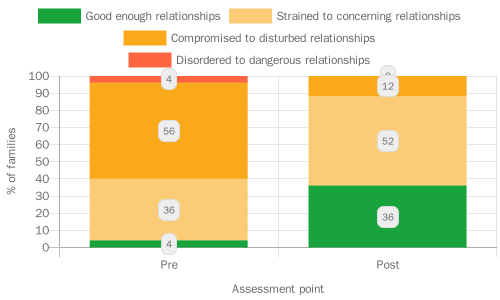
Further information about LEAP’s PAIRS One-to-One Service and the outcome measures we use to monitor change, can be found later in this report.
LEAP’s Natural Thinkers Service – Nature play in early childhood
Children living in the LEAP area are less likely to have a private garden and good access to green space4. Given this, LEAP delivers the Natural Thinkers programme which supports early years practitioners to provide high quality outdoor learning for children and more recently offers local ‘stay and play’ sessions for families. The aim of this service is to improve children’s wellbeing and their communication and language development.
It’s a highlight of our week as we live in a flat with no outside space & she has become confident exploring this session as if it were her own garden.
Looking for frogs and newts and actually finding them. Children absolutely loved hunting. Also, the hunt and find various insects and leaves with a tick-off sheet was so much fun too.
Data collected from 147 children, shows children were more involved in activities and had improved wellbeing at the end of the service.
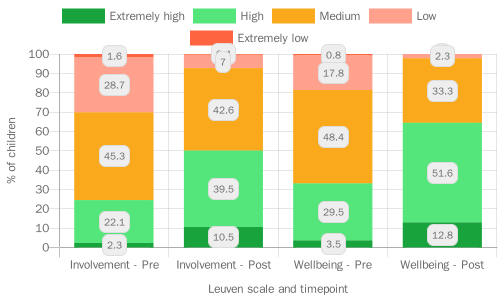
Boys had lower levels of involvement and wellbeing compared with girls at the initial assessment. However, this gender gap had narrowed by the end of the programme, which suggests that Natural Thinkers activities may be particularly beneficial for boys.
5.0 Parental health and wellbeing
Having good physical and mental wellbeing is important in enabling parents to provide a positive, healthy, and stable home environment for children. By contrast, being in poor health or experiencing mental health issues can be a barrier to positive parenting5.
LEAP works with parents at the following stages:
- In pregnancy and postnatally
- In the early years through group sessions
LEAP also provides support to parents at risk of, and experiencing, domestic abuse during pregnancy or their child’s early years.
Here we present emerging findings from two of our services that work directly with parents and caregivers to improve their health and wellbeing.
LEAP’s Community Activity and Nutrition (CAN) service is a targeted programme that aims to support pregnant women in the LEAP area with a Body Mass Index (BMI) of over 25 to adopt healthier diet and activity behaviours. It has a specific focus on engaging women from Black, Asian and minority ethnic backgrounds. We found that 77% of women reached and engaged by the CAN service are from these backgrounds.
Data from 485 women shows that CAN is helping all women to be more physically active by walking more during pregnancy. This increase in physical activity is continued after women have given birth (Figure 4). Women from Black, Asian and minority ethnic backgrounds have lower levels of physical activity when entering the service, a difference which is consistent with national surveys. This difference is seen both before and after participation in CAN6.
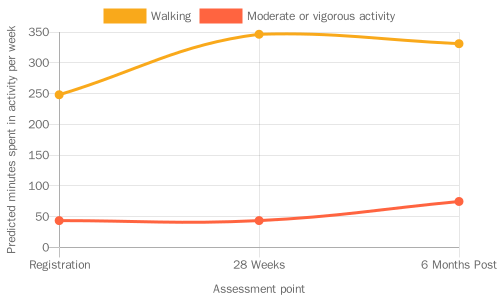
In future research, we hope to explore birthweight outcomes for CAN participants, linking these to physical activity data and participant characteristics. Find out more
LEAP’s Enhanced Casework (Gaia) service offers holistic support, to LEAP parents who are experiencing, or are at risk of, domestic abuse during pregnancy or their child’s early years.
This includes emotional support and practical assistance with issues such as housing and legal matters.
By the end of engagement with the service, just over a third (36%) of clients said that they had experienced an end to all types of abuse and controlling behaviours. Abuse frequently continues for years after the end of a relationship, so this finding is not unexpected. It highlights the importance of signposting people to continued support. After engaging with the service, all clients said they now felt confident about accessing help and support relating to domestic abuse.
The service team monitors changes in clients’ levels of psychological distress using the CORE-10 validated measure. Analysis of average scores shows a significant decrease in clients’ psychological distress from intake to the last session. At exit, no client had severe or moderately severe distress, compared with 22% of clients at intake (See Figure 5 below).
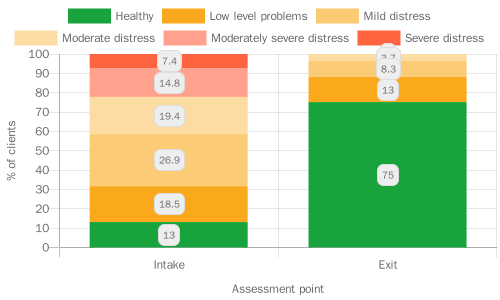
6.0 Parental knowledge, skills, and behaviours – the influence of parents on child development
LEAP services aim to equip parents with the knowledge, skills, and behaviours they need to provide their very young children with the best start in life. Here we report on findings from services which focus on behaviours that we know from evidence have a positive impact on children’s long-term outcomes. These include positive parenting, the home learning environment and breastfeeding.
Parenting and parent-infant relationship – the importance of parent-child bonding
- As a result of participating in the Baby Steps programme and/or the Circle of Security Parenting programme, parents feel more knowledgeable and confident about parenting, and enjoy being a parent more. Some parents, however, still felt low or moderate confidence about dealing with the stresses of being a parent. LEAP would be interested to explore this with families to understand if there is more we can do to support their confidence about managing these stresses.
- Parents taking part in LEAP’s Baby Steps programme developed a closer relationship with their unborn baby over the course of the programme (measured using the Prenatal Attachment Inventory7). Though attachment does tend to increase throughout pregnancy8, it is encouraging that we observe a significant positive change among Baby Steps participants, as higher levels of prenatal attachment are associated with positive health behaviours in mothers and secure attachment in infants9 10.
- Pregnant women living in relatively less deprived areas, however, seem to have better attachment to their unborn babies than pregnant women living in more deprived areas. This difference is seen both before and after participation in Baby Steps. Risk factors for the development of prenatal attachment include poor maternal mental health, minimal social support, and smoking during pregnancy. These factors can be more often seen in mothers from less advantaged backgrounds11. LEAP continues to try to better understand and address differences in prenatal attachment.
- A caregiver’s perceptions about their infant’s thoughts, feelings, and intentions towards them plays a large part in how the caregiver behaves and interacts with their baby. This has consequences for the infant/child. Feelings of ‘warmth’ (e.g., ‘my baby smiles at me’) positively influence the development of the caregiver-infant relationship. However feelings of ‘invasion’ (e.g. ‘my baby wants too much attention’) can have a negative impact. Participation in Circle of Security Parenting seems to strengthen the relationship between parent and baby, significantly increasing feelings of warmth and decreasing feelings of invasion (measured using the Mothers Object Relations Scale12).
- Reflective functioning refers to a parent’s ability to think about their own and their child’s mental states (e.g., feelings, desires, wishes, goals and attitudes). This ability is an important steppingstone to other positive parenting behaviours (such as responsiveness), which help the development of secure attachment and emotional regulation in children. 13Parents who engage in LEAP’s Parent and Infant Relationship One-to-One Service (PAIRS 1:1) experience some improvements in reflective functioning (measured by the Parental Reflective Functioning Questionnaire (PRFQ14).
Home learning environments
- Two of LEAP’s communication and language development (CLD) services, Sharing REAL (Raising early achievement in Literacy) and Supporting Babies’ Next Steps, are helping all parents to feel more knowledgeable and confident in supporting their children with early communication and language. This impact was most notable for parents with English as an additional language who overwhelmingly reported a very positive change in their knowledge and confidence. Approximately 40% of parents and carers that take part in LEAP’s communication and language development services speak English as an additional language. As children with English as an additional language are significantly less likely than their peers to have a good level of development at the end of reception year, 15 this may be an area in which LEAP is helping to reduce inequalities. LEAP will be working to better understand how and why LEAP’s CLD services may be particularly beneficial to parents with English as an additional language. Our aim will be to share this learning across the programme and beyond.
7.0 Practitioner skills and early years services – quality provision in early years settings
Feedback on LEAP overall is very positive, with families rating their experience of LEAP services very highly. Families say they find staff and volunteers to be welcoming, helpful and knowledgeable. Families trust LEAP staff and volunteers and feel that they understand their needs.
LEAP’s approach is underpinned by our work with communities and peer engagement. We’ve found that families are extremely likely to recommend LEAP services to their friends and family (based on LEAP’s overall recommendation score). This is true for all families, across all ethnic groups and for families living in relatively more and less deprived areas. Asian families, however, when compared with families from other ethnic backgrounds, were slightly less likely to ‘strongly agree’ that overall, their experience of LEAP services had been positive. We don’t know why this is, but this is an area that might warrant further investigation.
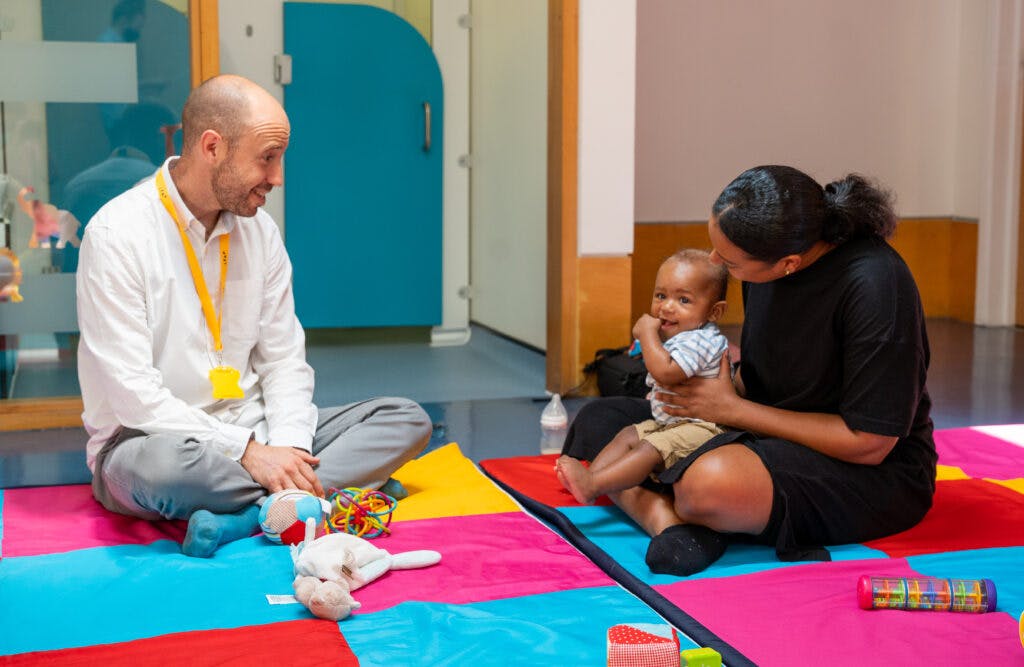
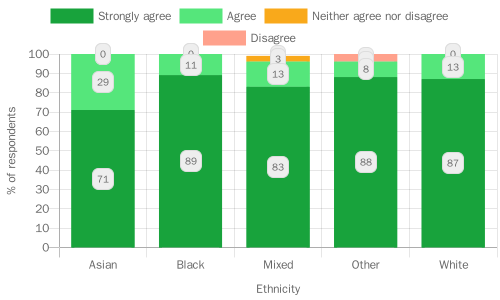
We also found that families living in more socio-economically deprived areas of Lambeth and surrounding neighbourhoods were less likely to ‘strongly agree’ that they trust LEAP staff and learnt something new from LEAP services, compared with families living in relatively less deprived areas. This mirrors other studies that have found a link between families experiencing financial difficulties and levels of trust and engagement with support services, because of factors including daily stress and previous negative experiences of public institutions16 17.
LEAP also provides training and professional development opportunities to local practitioners. This helps support the provision of high-quality early years services. Practitioners rate LEAP’s support very highly, providing consistently positive feedback. Practitioners are highly likely to recommend LEAP’s workforce offers to their colleagues.
“(The facilitator) was very warm, approachable, clear, patient with our questions and very helpful”
8.0 Conclusion and next steps
The findings presented in this report demonstrate the achievements and progress of LEAP services to date, both individually and collectively. In terms of overall reach and engagement, LEAP is steadily working towards achieving our initial target of reaching 10,000 children. LEAP is also demonstrating success in being able to engage families from diverse backgrounds, reflecting the overall LEAP population. This finding is extremely important in demonstrating our contribution to reducing inequalities at the population level. There are, however, some areas to explore about further improving our reach, particularly in terms of involvement of more fathers, and pathways supporting parents and families to use multiple services.
Within the specific domains explored in this report, the changes in outcomes (measured by validated tools) are promising indications of the positive impact of the specific services. The PAIRS One-to One Service is innovative in its approach. These initial indications of improved attachment could be very significant for services within Lambeth and beyond.
Likewise, improved outcomes in pregnancy demonstrated by an increase in physical activity and improved parenting knowledge and practice also hold great promise. Better understanding of patterns of inequality in outcomes will be crucial moving forwards.
In this report it has not been possible to share outcomes across all services due to data availability, but LEAP continues to build our database of quality evidence through our Shared Measurement System. Future annual learning research will include larger and more complete data sets, covering all key domains of our theory of change, as well as additional child development outcomes data. Additionally, we intend to gain access to some key administrative data sets and to have linked data from Health Visiting and the National Child Measurement Programme data sets.
LEAP is also committed to continued learning and will invest in additional research activities outside of the routine monitoring data which is presented here. Specifically, LEAP will invest in detailed reviews of services as well as a programme-wide evaluation to be conducted by our partner Dartington Service Design Lab. In addition, we will work closely with our partners in Lambeth and beyond to share and build on the early findings presented in this research.
We will spread good practice and work together to address challenges and difficulties affecting our local populations, particularly in light of the current Cost of Living crisis.